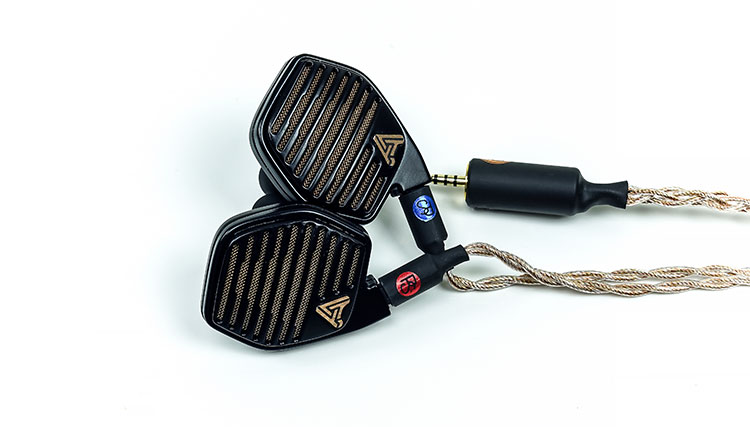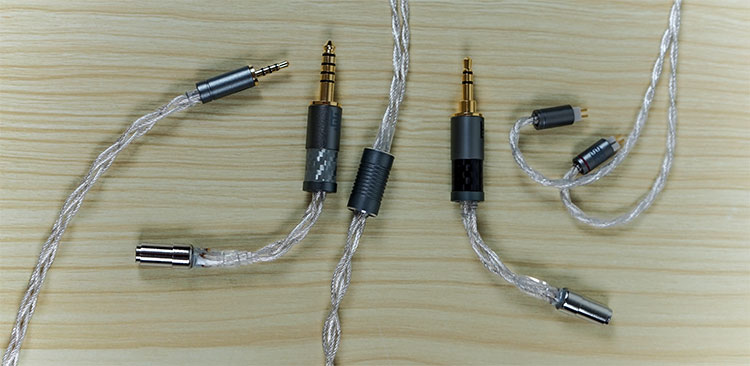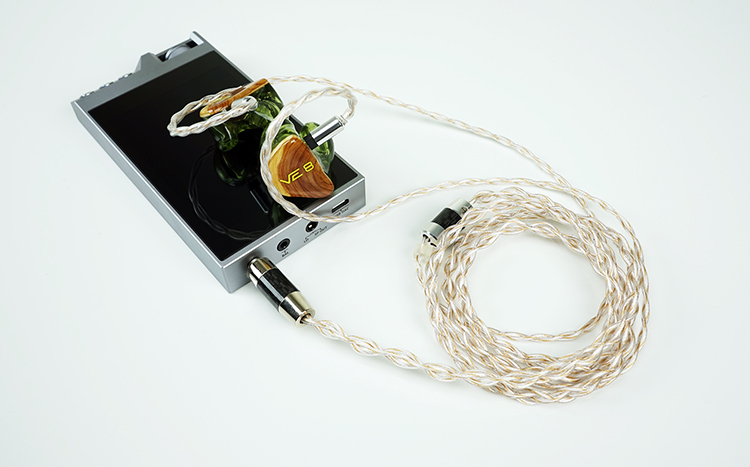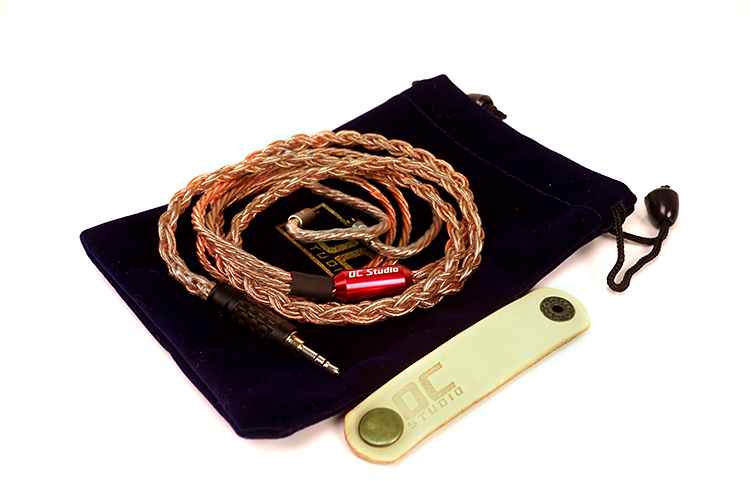Performance Impressions
Three words to best describe the Exo Tri Copper sound; weight, body, and texture. To some extent, the Tri-Copper is aiming for the same territory as the EA Lionheart with its rich but detailed sound but there are some nuanced differences in their final presentation such as the degree of forwardness in their bass response.
Certainly, if you are throwing out your stock Plastics One CIEM cable this is going to be a huge step up in terms of dynamic range and staging capability. The timber of the Tri-Copper is much richer and warmer but not to the point where it bleeds all over the place.
Instrumental separation on the A18, for instance, is still very spacious sounding using the Tri-Copper. Pretty much every instrument, be it rock, synth or percussion is laden with some beautiful even harmonic overtones without every sounding in danger of being overly rounded or muted down to get there.
True enough, compared to some silver variants the Tri-Copper might sound a bit darker. It does not offer the same sparkle and treble forwardness as PW Audio’s The Flash or the level of air and neutrality as their 1906s 2-wire. What it will deliver more on is on the other side of the spectrum; low-end girth and impact.
The Tri-Copper has some seriously full-sounding bass presence and generally, a much better level of body and texture than neutral or thin midrange sounding monitors like the A18 and the Nobel Katana will lap up. It is also a punchy low-end, rather than a soft flabby response. I actually found the Tri-Copper to be thicker sounding but nicely controlled.
Synergy
Sources
The Exo Tri-Copper plays well with most IEMs I used but ultimately it depends on your own preferences in terms of genre matching and how far you want to take it.
If you are after a warm impactful musical quality then even neutral DAPs will give you that. DAPs such as the AK240 and the Onkyo Granbeat still retain enough treble clarity and sparkle to offset the additional low-end weight and prevent the signature from becoming overly dark.
Warmer or punchier DAPs such as the DX150 with the Amp 4s card will deliver an even thicker and punchier low-end but will also sound a touch softer and perhaps overly rounded with too much even harmonic bias. Some might prefer that beefier response compared to the slightly cleaner airier presentation of Sabre DAC-infused neutral DACs such as the DX200 and the Granbeat.
The Tri-Copper paired with the R6 was a great pairing for those that like low-end power. A little thicker and with more sub-bass rumble than say the Granbeat Sabre’s more neutral sound but still kept a beautifully smooth and open presentation.
IEMs
Ideal Pairings
The Tri-Copper is a super easy cable in terms of which IEMs ideally pair with it. Any IEM with a peaky top-end, lean low-end, neutral, or sterile mids will get a nice injection of additional warmth and body as well as taper down any treble peppiness.
It will not completely change the tonality of any IEM but it might just help with the final touch. Factor in a warmer DAP or a natural-sounding source and it could be an excellent pairing.
Excellent examples included the A18 from 64 Audio with its very detailed, expansive but somewhat neutral-sounding tonality and clean but slightly thin-sounding timbre.
The Tri-Copper pairing brought in some welcome low-end body and a richer instrumental timber and just smoothed out the Tia high a little in return. I got pretty much the same change-up in the presentation also with the Katana only the low-end sounded just a little thicker and more impactful than the A18.
Surprising Pairings
Having said all that, dark-sounding IEMs with stock Plastic One cables will actually sound, well, less dark. It really comes down to the quality of the copper with stock cables often using a poor quality OFC that loses a fair amount of dynamic range as a result.
The Tri-Copper will bring a lot of that lost dynamic range back though it will not suddenly inject a dark-sounding IEM with a ton of treble. One such IEM was the Aurisonics ASG1+ got a welcome lift in clarity and air with the Tri-Copper compared to its stock cable.
Select Comparisons
Astral Acoustics Libra
$520
Technical
The Libra is a type-2 25AWG silver-gold alloy 4-wire cable from Astral Acoustics. You can also get it in an 8-wire configuration for around $780. This is Astral’s flagship cable with a soft PVC jacket that handles similarly to the Tri-Copper.
The braiding is a little looser but the PVC jacket is a touch softer though perhaps due to its lower Type 2 Litz configuration it does not feel quite as dense.
The Libra uses Eidolic Premier connectors as well as Eidolic jacks in a gunmetal aluminum barrel with carbon fiber print on the jack barrels. It is a little tidier looking than the Tri-Copper heat shrink finish but it is a little less grippy in comparison.
Soft plastic strain relief is more noticeable on the Libra than the Tri-Copper. Aesthetically both have superb color matching for all barrels, cable hue, and connectors.
Performance
The Libra is a smooth-sounding cable with a musical lilt but it is more balanced sounding than the full-bodied and warmer Tri-Copper. It has a bit more air and treble detail, particularly in the lower treble in comparison to the darker tone of the Tri-Copper.
In contrast, the Tri-Copper is far more impactful and powerful sounding with a much better sub-bass rumble and mid-bass presence.
The instrumental timbre on both is far from neutral but again the Tri-Copper delivers more body and texture to notes whereas the Libra is a more relaxed and slightly sweeter tone. Mids and vocals on the Libra are a little more neutral sounding and further back compared to the Tri-Copper presentation.
Effect Audio Lionheart
$499
Technical
The Lionheart is part of Effect Audio’s heritage series and is a 4-wire 26AWG UPOCC copper mixed with EA silver-plated and EA Gold-plated copper for some in-house tweaking. In some ways, this is a very similar mix of materials to the Tri-Coppers blend.
Both use their own in-house jacket material with the Lionheart using EA Ultraflex and the Tri-Copper using PS Insulation. Both are tightly braided with similar microphonic and memory retention-free handling. The Tri-Copper does not use memory hook materials whereas the Lionheart does use memory hook sleeving.
Performance
The differences between these two cables are far more nuanced than the Libra and Orpheus MK5. AT their core level both are musical, rich, and full-bodied with a little take off the treble response in terms of air and extension in exchange for a much “bigger” and more impactful low-end. Both have a euphonic timber with a slight even harmonic bias making them both smooth-sounding cables.
However, there are differences. The Lionheart is a little weightier on the low-end compared to the Tri-Copper’s punchier performance. It is also a little further forward and with a bit more quantity.
Staging on the Lionheart is also a little wider so you will get a slightly better level of instrumental separation and more engaging imaging performance. The Tri-Copper, however, has a little bit more air and treble extension than the Lionheart. the Lionheart energy tends to focus a bit more on the upper mids and lower treble.
OC Studio Orpheus MK5
$259
Technical
The Orpheus MK5 is a 24AWG 8-wire UPOCC copper cable from Taiwan. The fact it is 8-wire will mean it is denser and heavier than the Tri-Copper 26AWG 4-wire however it is still a fairly pliant and easy to work with cable. It has low microphonics and zero memory retention.
That heavier gauge means it also has some heat shrink plastics for memory hooks to help balance it out around the ear.
OC uses in-house branded terminations for the MK5 including a cryo-treated OC 35CFRT 3.5mm jack and TCGP 2-pin gold-plated 0.78mm sockets.
The y-split barrel is a nice red finish and slightly heavier than the rose metal finish of the Tri-Copper barrel. You can opt for alternative connectors such as 2.5mm balanced and MMCX/Fitear/Shure/UM Pro connectors.
Performance
The Orpheus is the densest sounding copper cable I have and makes the Tri-Copper positively balanced sounding in comparison. It is a truly hard-core copper sound with immense weight and impact in its low-end.
By comparison, the Tri-Copper has some excellent richness and texture but just pulls back a little from the density and physicality of the Orpheus MK5. Instead, it leaves a bit more space and focuses instead on a slightly more even-handed approach mixing impact and body with a more of open midrange and air in its treble response. As such it is a toucher lighter in its timbre and pacier in its low-end.
The Orpheus is the slower sounding and slightly less resolving of the two cables but is the more aggressive. The copper tone of the MK5 is for people who positively burn at the sight of silver it is that hardcore. An immensely competitive and fun-sounding cable for the price point.
Our Verdict
As a first-time review of Plussounds’ aftermarket cables, the Exo Tri-Copper cable is very competitive indeed. It brings all the hallmarks of a solid copper cable including enhanced warmth, body, and low-end impact yet still retains a smooth and detailed top-end.
It will be a darker experience if you are coming from a silver cable but it is also a more musical and less fatiguing experience than those clarity monsters.
Horses for courses though since copper is a decided ‘preference in tone’ I would recommend this to anyone with a neutral sounding or bright IEM who wants to fatten the low-end a bit, richen the timber and take the edge off the treble.
Visually, it is a treat with some striking rose gold tones and excellent build quality. It is easy to manage and noise does not travel up the pipe when handling.
A few nitpicks would be the quality of packaging and saying somewhere on the bottom what the model is plus also an IEM organizer strap but they are relatively minor. Other than that, the Exo Tri-Copper is an excellent cable for those who love a warm “phat” sound.
PLUSSOUND Tri-Copper Specifications
- Overall Length 4 ft / 48 in / 1219.2 mm / 121.92 cm
- 26 American Wire Gauge (AWG)
- Wire Type UP-OCC
- Construction Type 6 Litz





